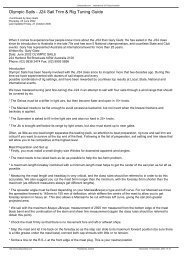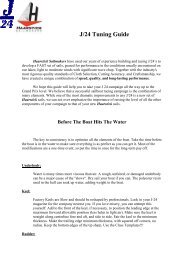Rhodes19 Doyle Tuning.pdf - Sailmaker.org
Rhodes19 Doyle Tuning.pdf - Sailmaker.org
Rhodes19 Doyle Tuning.pdf - Sailmaker.org
Create successful ePaper yourself
Turn your PDF publications into a flip-book with our unique Google optimized e-Paper software.
DOYLE One-DesignRhodes 19 - <strong>Tuning</strong> GuideRhodes 19 ClassLinkRhodes 19 Home <strong>Tuning</strong> Guide Sail PricesOur sails have won the Rhodes 19 National Championship for the seventeenth timein twenty-two years! We have continually upgraded our designs and cloth selection tomake our sails even better year after year!SETTING UP YOUR RHODES 19 FOR DOYLE SAILSBEFORE STEPPING THE MAST:1. Clean and lubricate turn-buckles.2. Check your mast step location fore and aft with a tape measure; run the tape fromthe intersection of the center of the transom and the deck to the aft edge of the maststep. This dimension should be 12 feet 6 1/2 inches.TUNING YOUR MAST:1. Center mast with upper shrouds, check it by measuring to port and starboardchainplate with a tape measure attached to the jib halyard.2. Tension uppers and lowers for existing wind conditions. We use a Loos TensionGauge, Model A, for consistent settings.3. Tension uppers to 150 lbs. Tension lowers equally to 80 lbs. Sighting up aft face ofthe mast to check for straightness. It is essential that the mast is straight.SHROUD TENSION:WIND 0-4 4-8 9-14 15+Lowers 0 0 80 80Uppers 110 110 150 200An increase in overall rig tension results in greater headstay tension.TRIMMING THE SAILSIt is important to mark all your shrouds, sheets, tracks, outhaul, etc. Keep records ofyour set-ups, the conditions you sail in and how your speed is. It is essential to be ableto duplicate settings from race to race and to know exactly how the boat was set upwhen you were going fast. Check to make sure the soft end of the battens are insertedfirst.MAINSAIL:1. Trim the mainsheet hard enough to make the top batten parallel to the boom. Oncethe boat has accelerated and you want to point higher, trim harder and cock the topbatten slightly to weather. If the mainsheet is too tight (evidenced by top battenhooking way to weather) you will stall the main and slow down.2. Set the traveler car up to the inner edge of the windward seat so that the boom is onor just below center line. As the breeze increases, gradually drop the traveler to depowerthe main.3. Use the outhaul for balance. Adjusting the outhaul changes the depth of the lower 1/3of the main which affects helm, speed and pointing.
KNOTS: OUTHAUL TENSION0 - 5: eased 1 1/2"6 - 10: eased 1"11 - 14: eased 1/2"15 +: maximum4. The cunningham is used to position draft in the main. Your goal should be to keep themaximum draft point 50% back in the sail. We use no cunningham up to 10 knots,enough to remove most of the wrinkles 11 - 15 knots and progressively tighter in higherwinds to remove all wrinkles.5. Applying the vang. Upwind the vang is lose in most conditions, off the wind, however,we apply the vang just enough to make the top batten parallel to the boom. Be careful!Rhodes 19 booms are not that strong, so in a breeze, watch how much the boom isbending.JIB:1. Luff tension is one of the most critical parts of the boat. In 0 - 10 we sail with mediumwrinkles in the luff, 11 + set luff progressively smoother. If you feel you are not gettingenough power in chop, try easing luff tension.2. Jib leads. In every up-wind breeze condition, the jib lead should be positioned so thatthe jib luff breaks evenly when you luff up slowly into the wind. Moving the lead forwardwill make the jib break quicker down low while moving the lead aft makes the luff breakquicker up top.3. Telltales. Keep both windward and leeward yarns streaming aft.
HEADSTAY SAG - LIGHT AIR:To increase pointing and upwind speed in light air you must carry a loose headstay. Withmainsheet tension and backstay tension you can adjust the amount of headstay sag.With the backstay loose the headstay should be able to make a 12" circle.BACKSTAY:1. Pulling on the backstay has two effects. First, as the mast bends, the upper half of themain flattens and the leech opens up - which relieve helm and heeling. Second, it makesthe forestay tighter which flattens the entry of the jib and eases its leech, thusincreasing pointed ability and reducing heeling. Whenever adjusting the backstay, youshould adjust the mainsheet.WIND STRENGTHBACKSTAY 0 - 6 7 -10 11-15 16-18 19+TENSION none 1/4 1/2 3/4 maxWIND: 18 and Up, Everyone hiking hard.HEAVY AIR TECHNIQUESSheet mainsheet and jib hard. When the breeze gets to be much over 20, the travelershould be dropped to leeward full time and start playing the mainsheet. Outhaul shouldbe maxed out. The cunningham should also be on hard. Backstay between 1/2 andmaximum playing it in the waves and puffs. If you have some chop, it is all right to havesome wrinkles in the luff of the jib. However, you’ll probably need to tighten the jib luffand move jib leads aft. If you get to the point where you have heavy weather helm andyou are doing all of the above, move the jib lead even further aft and ease the jib sheetto put some twist in the upper third of the sail and apply more backstay. Objective in 18- up: Keep boat flat and punching through waves. Feather the boat through bad waves.DOWNWIND GUIDELINES1. Set the vang so the top batten is parallel to the boom.2. Ease cunningham, outhaul and release backstay.3. Raise spinnaker pole until spinnaker clews are level.4. Trim the spinnaker so there is 6 - 12" of curl in the luff.5. Keep the pole perpendicular to the apparent wind.6. While reaching, keep your speed up by heading higher in the light spots or choppywater. Head off only in the puffs and don’t sail unnecessarily high early in the leg.7. On the runs, jibe in the windshifts to stay on the headed tack.OTHER HELPFUL HINTS1. When in doubt, let it out.2. Shim mast tightly where it goes through the deck.3. Keep keel, rudder and bottom in the best shape possible.4. Get a good start.5. Do not overstand marks or sail in another boat's bad air.NOTE: These are guidelines, not gospel. What is fast for your boat may vary slightlyfrom our charts. Remember this is only a game we are playing. Have fun and goodsailing!
















